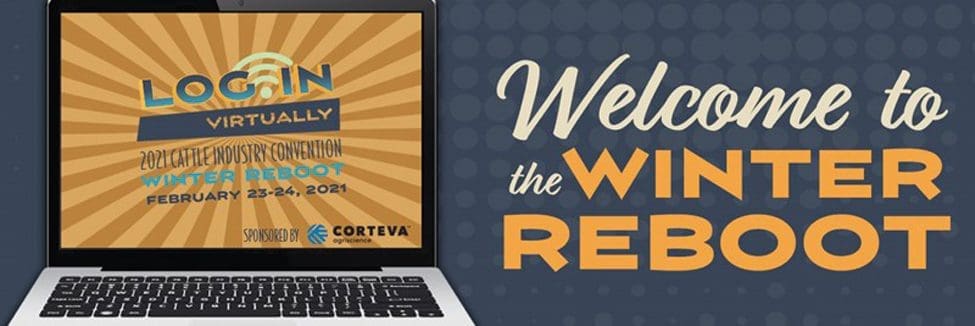2021 CattleFax Outlook Seminar
By Patti Wilson Contributing Editor
Internet technology scored high marks on Feb. 24, as CattleFax went ahead with its annual seminar during the Cattle Industry Winter Reboot.
All the bells and whistles one would see at the Cattle Industry Convention were included, mainly the best charts and graphs you’ll ever study.
CattleFax CEO Randy Blach started the program with an overview of the past year. He listed the 2019 Tyson fire and 2020 COVID pandemic as major influencers on agricultural markets and consumer buying habits.
These “Black Swan” events backed up two million head of cattle along the supply chain, some of which are still working their way through the system. Blach pointed out that we continue to make headway. Though prices soared for beef, producers in the country saw little profit. This lack of profit, along with dry weather, has led to significant herd contraction and put an end to the current cattle cycle.
What’s good? Record meat U.S. meat consumption has put beef at the center of the plate with the strongest demand in 30 years. Total retail sales for beef was up 10 percent, dollar sales were up 18 percent, and beef’s share of the increase in protein spending was 45 percent. Blach noted that government payments to families due to the pandemic were helpful.
Blach said the future holds significant inflation and higher interest rates. Our increase in gross domestic product (GDP) will depend on recovery from COVID, although the economic landscape for agricultural products is likely to be positive.
Weather
Meteorologist Art Douglas, Ph.D., never disappoints when presenting his weather outlook.
He explained that our devastating cold spell in February was a result of a strong La Niña pattern in the Pacific Ocean, with a large cold area near the equator. Although it has “quieted down” and currently allows for better weather conditions, it is sure to return this summer, with unfavorable repercussions.
Forecasting U.S. weather, Douglas expects California to suffer severe drought in 2021, along with much of the Southwest. The northern Plains may be cooler than normal and experience dry conditions, though not as severely as California. The East Coast can expect to be extremely hot.
How does Douglas formulate these forecasts? It seems like commonsense work. He explained that weather records have been kept in the U.S. since the 1800s. There were three other years, one dating back to the mid-1800s, when our country suffered the same polar vortex we endured last February. Weather patterns following these events have been predictable each time. Drought follows the next summer, along with areas of above normal temps.
Explaining the “whys” of our weather, Douglas keeps close tabs on the ocean temperatures as well as sunspots, which basically control our wardrobes on earth. He said the miserable February weather was not an indication of “climate change.” If a polar vortex is a climate-change indicator, it means the planet has been on a crash course in 1856. That was 165 years ago, prior to the invention of the combustion engine and the industrial revolution.
Corn and Soybeans
Mike Murphy is CattleFax vice president of research and risk management services. He led the segment concerning grain prices, predicting corn prices to rise in 2021, partly due to the COVID crisis going away. He expects the U.S. corn crop to be somewhat smaller this year, as well.
Murphy said a major factor driving corn prices lower in 2020 was a reduced use of ethanol, as many people stayed home during the pandemic. Poultry and hog numbers have also been reduced, creating less need for feedstuffs.
Despite a bullish outlook in the export market, Murphy cautioned that there will be a record number of acres planted to corn and beans in the U.S. this year. The numbers seem astronomical, but Murphy’s question was, as per Douglas’s weather prediction: Are our corn and bean farmers going to drought out?
Keep an Eye on China
As China continues to recover from their African Swine Fever (ASF) outbreak, they are changing the structure of their pork industry. Small farmers in rural China often kept a few hogs on their properties. They were generally fed on table scraps or may have been pastured. Since ASF has wiped out many of these herds, this scenario has been replaced by large corporate hog farms using the most modern genetics and formulated corn and soybean based rations.
This, importantly, will open the door to U.S. exports of corn to China in 2021, as the pork industry continues to rebuild. They are also likely to import a large amount of soybeans.
Rounding out his presentation, Murphy predicted hay prices to hover around $160/ton, with a wide variation in prices, and crude oil to reach $75/barrel later in the year.
Cattle
Kevin Good, CattleFax vice president of industry relations, led his presentation by saying that we have about one-third fewer cattle in the U.S. than in 1980, yet we are producing more beef. The efficiency of our cattle production is remarkable, and the consumer needs to know.
Charts indicate the demand for beef is increasing in what is going to be a dry year. Cow slaughter will remain steady, and drought conditions will contribute to a “mild liquidation.”
Beef slaughter numbers are slated to increase in 2021, after 2020’s “Black Swan” backup of cattle unable to go to harvest. These heavy cattle continue to work their way through the system, clearing the way for more moderate weights in 2021. Cattle on feed numbers are expected to be up 2.4 percent, and should enjoy higher prices the second half of the year.
Total 2021 slaughter will reach 33.5 million head. The growth of beef exports to China will be a necessary benefit.
Beef production will top out at 470 million pounds in 2021, up 1.7 percent. Pork will drop 1.5 percent, and will chicken remain stable at a 0.1 percent increase. Total meat exports will grow a healthy 5 percent.
The USDA Choice-and-higher grade of 83 percent is projected to drop back a point as more moderate-weight cattle make their way to harvest.
Emphasizing the importance of export markets, Good related that 20 percent of the value of fed cattle can be attributed to export demand. Much of these exports are offal products and items not consumed in the United States.
Good’s Price Projections
Fed steers are projected to bring $119/cwt. in 2021, with three to five years of tight supplies ahead. The fourth quarter should bring the highest prices.
800-lb. steers should average $145/cwt., with a $135 to $160 range.
Calves are looking at a $168/cwt. average, with a range of $160 to $180. Good expects a rally at year’s end. Cull cows will average $64/cwt. and bred stock $1600.
Blach’s Long-Term Outlook
With the cattle cycle over, the price lows were in 2020. Prices of all classes of cattle are due to go up.
Food service will increase as pandemic worries subside. Plant-based proteins will continue to increase their market share, although gains are expected to be slow.
Cow-calf producers and margin operators will see a significant improvement in profits.
U.S. agriculture will play a major role in feeding a global population that is increasing by 83 million each year.
Consumers will continue to demand information on their food, its source, sustainability and treatment of livestock.
Blach emphasized the importance of price discovery in fed cattle. He expects increased technology and robotics in packing plants, which will slowly increase in number.
CattleFax was optimistic in this year’s outlook. Let’s hope they’re on target.








